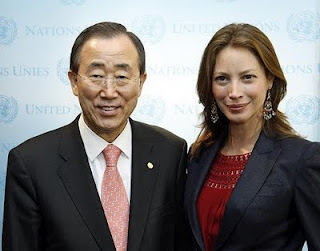-
VIDEO: Nicholas Kristof On Comprehensive Approaches to Family Planning
›October 2, 2009 // By Wilson Center Staff“Poor countries can’t begin to deal with food issues, with economic pressures, with conflict and shortages of water and grassland that may lead to social conflict, unless they begin to deal with population problems,” journalist Nicholas Kristof tells ECSP Director Geoff Dabelko in a video interview.
But “the single most effective contraceptive isn’t any kind of device,” Kristof says, “it’s girl’s education. And that has the most extraordinary impact on birthrates.” Unfortunately, this approach to family planning has “been neglected in the last 20 years.”
Empowering women and girls may be our best strategy for fighting poverty, claim Kristof and WuDunn in their new book, Half the Sky: Turning Oppression into Opportunity for Women Worldwide, which was launched at the Wilson Center.
Half the Sky tells the transformational stories of women and girls who are the “face of statistics” on four appalling realities: maternal mortality, sexual violence, and lack of education and economic opportunities. -
Missives From Marrakech: Enter the Environment
›October 2, 2009 // By Gib Clarke
“Contraception is the cheapest way to combat climate change,” read the headline of The Telegraph in mid-September, announcing the release of “Fewer Emitters, Lower Emissions, Less Cost,”a study from the Optimum Population Trust (OPT) and the London School of Economics (LSE). Similar stories appeared in newspapers around the world.
Though there has been near-universal agreement that the OPT-LSE paper oversimplifies the link between demography and climate change, the buzz among the family planning and environment communities has continued during the IUSSP conference in Marrakech. Perhaps this is because demographers are not used to appearing in the press except when discussing census results. More likely it is the timing of the report, with the Copenhagen conference on climate change coming in December.The buzz hit a peak on Thursday at the IUSSP, with a plenary presentation examining the links. Wolfgang Lutz jumped right in, noting that it’s not as simple as the OPT-LSE study makes it. Population growth is important, but size is not the only thing that matters; other aspects such as age distribution, household structures, and levels of urbanization come into play as well.
In addition, between population size and climate change lie a number of intermediary factors, such as consumption levels, technology improvements, and greenhouse gas (GHG) emissions. Lutz argued that demography has a unique contribution to make to the climate discussion, for no other discipline understands the composition of different populations in different places both now and in the future. Therefore, demographers should explain how different groups will contribute to climate change, and how they will suffer the consequences, so that adaptive capacities can be strengthened and social programs can fill the gaps.
Leiwen Jiang described research conducted by some of the giants in climate and demography: National Center for Atmospheric Research, International Institute for Applied Systems Analysis, and Population Action International. Their work uses a “PET” model – Population, Environment, and Technology – which looks at how the PET elements impact four critical predictors of GHG emissions: consumption, energy use, labor, and savings. A forthcoming paper by this group will delineate the complete findings, including the potential for GHG “savings” brought by decreases in fertility and thus reduced population growth, as well as the added GHG due to future urbanization.
Susana Adamo took a step back to show the audience the view from 30,000 feet – literally, with maps demonstrating that population density is highest in areas most vulnerable to impacts of climate change, such as sea-level rises, droughts, floods, and other severe weather events.
Unfortunately, one of the stars of this research, Brian O’Neill, was unable to attend, due to health reasons. His research, to be published soon, is highly anticipated, and should add additional quantitative fuel to the fire.
Not Just Climate
Environmental links with population and demographic factors have also factored in other parts of this “demography” conference. A host of sessions, many organized by the Population-Environment Research Network, have explored linkages between population growth, migration, and urbanization on the demographic side; and deforestation, natural resource management, and environmental degradation on the environmental side. Questions concerning these and other environmental factors have surfaced at panels exclusively dedicated to other topics such as family planning. Some sessions examined how population and environment concerns can be jointly addressed.
It is encouraging to see demographers and reproductive health specialists taking climate and environmental factors so seriously. The response from the environmental community has been mixed, with some interest in population issues, but also some opposition from the climate community to including discussions of family planning in an already controversial topic. At a similarly large gathering of environmentalists and conservationists, the 2008 IUCN conference in Barcelona, only two sessions addressed health or population. So we have a long way to go progress to unite these communities of researchers and practitioners, and come together in a truly fruitful engagement.
Photo courtesy World Bank Photo Collection. -
Missives From Marrakech: 50 Years of Counting. And Counting.
›September 29, 2009 // By Gib Clarke Demographers often get a bad rap for being boring. There’s a saying that demography is all about sex—but the details aren’t as much fun. To find out, I’m in Marrakech, Morocco, reporting on the biennial gathering of number crunchers, the 26th conference of the International Union for the Scientific Study of Population (IUSSP). After the first day, I have only 4 days, 86 panels, 327 presentations, 5,340 PowerPoint slides, and 426 poster presentations left to go.
Demographers often get a bad rap for being boring. There’s a saying that demography is all about sex—but the details aren’t as much fun. To find out, I’m in Marrakech, Morocco, reporting on the biennial gathering of number crunchers, the 26th conference of the International Union for the Scientific Study of Population (IUSSP). After the first day, I have only 4 days, 86 panels, 327 presentations, 5,340 PowerPoint slides, and 426 poster presentations left to go.
To most of you, this may not seem exciting. But it is terrifically important. For example, at a panel on maternal health, the presenters offered easier, more accurate, and less expensive ways to collect maternal mortality data, which led to a discussion of strategies for meeting MDG 5 and for improving maternal and infant health throughout the world. Similar panels addressed the challenges facing scientists and programmers working on issues as disparate as water, migration, and the effect of armed conflict on children.
For its 50th Anniversary, IUSSP also indulged in a bit of navel-gazing. Wolfgang Lutz called for more research on predictions and more policy recommendations—what he dubbed the “Demographers’ Transition” (an inside joke, to be sure). Ndola Prata’s “Opportunity Model” (developed jointly with Malcolm Potts and Martha Campbell), argues that use of contraceptives may increase simply if they are more available. Borrowing from marketing theory and such examples as remote controls and Post-It notes, the model generated quite an uproar. A UNFPA-hosted plenary on “After Cairo” closed the day with a strategic discussion about future population, family planning, reproductive health, and development strategies.
A Visit to the Hospital
At the Ibn Zohr Hospital’s crisis center in Marrakech, victims of sexual, physical, and psychological violence are treated and counseled free of charge. Though only founded in 2006, the clinic has defied expectations by helping hundreds of women and children each year, thanks in large part to an effective referral network comprising NGOs, media (especially radio), the police, hospitals, and health professionals. “Listening centers,” local outposts offering basic education on health and rights, are responsible for 56 percent of all referrals.
Ibn Zohr’s services are funded by the Moroccan government and UNFPA. Data has been collected since service delivery began, and shows that the overwhelming type of abuse suffered by women is physical (86 percent), while children under 15 report a mix of sexual (40 percent) and physical (43 percent) abuse, with more sexual abuse occurring among boys than girls.
Other IUSSP site visits included a rural reproductive health clinic, a center for abandoned children, and a house for female students. Too often, site visits are far away from the conference and before or after the main events, costing attendees extra time and money. Instead, the IUSSP site visits are here in Marrakech, where even the most experienced practitioners can learn more about Morocco’s unique blend of modernization and religious and cultural conservatism. These trips are truly unique and invaluable learning opportunities—organizers of similar conferences take note.
Gib Clarke reported from Marrakech, Morocco.
Photo courtesy flickr user DavidDennisPhotos. -
Dutch Minister for Development Cooperation Bert Koenders on the Future of Family Planning
›September 22, 2009 // By Gib Clarke“I think everybody…will agree that family planning is one of the biggest success stories of development cooperation. I also consider the paradigm shift in this field from top-down family planning (FP) to programs of reproductive health (RH) and rights for couples and individuals adopted in Cairo in 1994 to be a success story,” said Bert Koenders, the Dutch Minister for Development Cooperation, in a statement prepared for a roundtable discussion at the Wilson Center on future strategies in FP and RH.
Looking beyond the successes of the past, Koenders identifies a series of opportunities and challenges facing the RH community. He cites as the first opportunity the potential to “join forces” with the United States to meet Millennium Development Goal #5 (which focuses on maternal, sexual, and reproductive health, and family planning). He calls MDG 5 “the mother of all MDGs” and says that if it is not met, “then the other MDGs will not be attained either. It is smart economics to invest in MDG 5.” Other opportunities include public-private partnerships and the “growing awareness” in developed and developing countries alike.
The challenges, however, are significant. Youth, he notes, account for half of the world’s population and face barriers in access to reproductive health information and commodities. To overcome these barriers, we must first identify what adolescents and unmarried women and couples need, and recognize their rights to the same quality services as older and married women and couples. Koenders also says there is a growing opposition in many parts of the world to sexual and reproductive health and rights, and that programs must address this in order to be successful.
The roundtable discussion, to be held on September 22 at the Wilson Center, features Musimbi Kanyoro of the Packard Foundation, José “Oying” Rimon of the Gates Foundation, and Scott Radloff of the U.S. Agency for International Development. -
Weekly Reading
›Climate change is “the biggest global health threat of the 21st century,” says the final report of a year-long commission held by The Lancet and University College London. A Lancet editorial, “Sexual and reproductive health and climate change,” says that rapid population growth “increases the scale of vulnerability to the consequences of climate change” and that meeting the unmet need for contraception “could slow high rates of population growth, thereby reducing demographic pressure on the environment.”
Following the escalation of hostilities in Gaza, the UN Environment Programme’s environmental assessment found that Gaza’s underground water supplies are “in danger of collapse as a result of years of over-use and contamination that have been exacerbated by the recent conflict.” IRIN reports that climate change has led to lower rainfall and “slowed the recharge rate of the aquifer” under Gaza, while “rapid population growth and suburban sprawl” have left “little space for rainwater catchment.”
In “Arctic Climate Feedbacks: Global Implications,” the World Wildlife Fund says that “warming in the Arctic will likely have far-reaching impacts throughout the world, resulting in a sharp increase in harmful greenhouse gases and significant shifts in global weather patterns that could disrupt the lives and livelihoods of hundreds of millions of people.”
The Obama Administration’s Interagency Ocean Policy Task Force Interim Report—now open for a 30-day review and comment period—“proposes a new National Policy that recognizes that America’s stewardship of the ocean, our coasts, and the Great Lakes is intrinsically and intimately linked to environmental sustainability, human health and well-being, national prosperity, adaptation to climate and other environmental change, social justice, foreign policy, and national and homeland security.”
The Economics of Climate Adaptation Working Group estimates that climate risks “could cost nations up to 19 percent of their GDP by 2030, with developing countries most vulnerable,” and warns that the “historic pace of population and GDP growth could put ever more people and value at risk.” However, the group also contends that “between 40 and 68 percent of the loss expected to 2030 in the case locations – under severe climate change scenarios – could be averted through adaptation measures whose economic benefits outweigh their costs.” -
Combating Climate Change with Condoms
›September 17, 2009 // By Meaghan Parker Mountains of reports and studies have proposed expensive technological responses to climate change. But the scientists and policymakers working to protect the planet may have overlooked one of the easiest, cheapest ways to reduce carbon emissions: contraception.
Mountains of reports and studies have proposed expensive technological responses to climate change. But the scientists and policymakers working to protect the planet may have overlooked one of the easiest, cheapest ways to reduce carbon emissions: contraception.
A recent study commissioned by the Optimum Population Trust estimates contraception would be almost five times cheaper than conventional green technologies. “Each $7 spent on basic family planning would reduce CO2 emissions by more than one ton,” researchers conclude, while low-carbon technologies would add an extra $25 per ton.
Slowing population growth could not only cut emissions, but also help poor families in vulnerable areas adapt to the impacts of climate change, such as land degradation, drought, and loss of food security. However, while governments of the poorest countries often cite population growth as a factor in environmental catastrophes, few address family planning as part of their adaptation strategies, IPS reports from a recent NGO forum in Berlin.
Enabling women to plan their families is not only climate-friendly, it’s also right. Currently, more than 100 million women worldwide want—and can’t get—modern methods of family planning. Better reproductive health care is “an end in itself,” with climate mitigation being the “side effect,” rather than the primary goal, Barbara Crossette writes in The Nation.
While many policymakers shy away from getting population in their environment, Secretary of State Hillary Clinton recently said, “It’s rather odd to talk about climate change and what we must do to stop and prevent the ill effects without talking about population and family planning.” At the Berlin forum, UNDP Administrator Helen Clark linked the goals of education, equality, and environmental sustainability in a “virtuous cycle.”
As the world’s largest per-capita emitter, the United States has a special obligation to examine its growth and consumption patterns. While the lives of Bangladesh’s 140 million people are acutely threatened by climate change, each new U.S. child and its descendants will be responsible for 160 times the carbon emissions of a Bangladeshi infant according to Oregon State University researchers writing in Global Environmental Change.
Unfortunately, condoms are unlikely to become heroes at Copenhagen. Some populous developing countries like India object to bringing population into the climate change debate without more focus on reducing consumption in developed countries. The Washington Post called the connection “unpopular,” and compared its odds to another “long shot”: geoengineering. Anti-contraceptive groups, development “silos,” sexism, and old-fashioned squeamishness are also formidable barriers to an open and nuanced discussion of how family planning can contribute to mitigation and adaptation.
Too bad, because as Suzanne Petroni writes in the latest issue of the Environmental Change and Security Program Report, “A careful discussion of the ways in which voluntary family planning can further individual rights, community development, and, to some extent, climate change mitigation, could increase awareness not only of the outsized contribution of developed nations to global emissions, but also of their appropriate role in the global community.”
A shorter version of this post will appear in the October issue of Centerpoint.
Photo courtesy Flickr user OsakaSteve. -
Weekly Reading
›The American Security Project (ASP) launched its Climate Security Index, which identifies climate change “a clear and present danger to the national security of the United States,” at an event hosted by George Washington University. ASP warns that “American leaders will face a multitude of tough choices as climate-induced national security threats begin to compete with and crowd out our ability to respond to traditional threats,” reports ClimateWire.
According to “Fewer Emitters, Lower Emissions, Less Cost,” contraception is almost five times cheaper than conventional green technologies as a means of combating climate change. “[E]ach $7 spent on basic family planning (2009 US$) would reduce CO2 emissions by more than one ton,” researchers conclude, while low-carbon technologies would add an extra $25 per ton.
Experts at a recent forum on sexual and reproductive health and development in Berlin also argued for making the population-climate link, although it did not appear in the Call to Action. Helen Clark, administrator of the UN Development Programme (UNDP), said that there is a “virtuous cycle formed by educating women and families in the developing world on the number of children they actually wish to have, improving the health of women and promoting gender equality, reducing poverty and hunger, and mitigating climate change.”
The World Bank has suspended International Finance Corporation (IFC) funding of operations in the palm oil sector over concerns that lending could be causing social and environmental harm, says Mongabay.com. World Bank President Robert Zoellick announced the move in a letter to NGO leaders who argued that IFC-backed palm oil production in Indonesia was fuelling deforestation, land grabbing, and human rights abuses.
In “Urban Poverty and Vulnerability in Kenya,” Oxfam warns that Kenya “is facing a new urban timebomb, with millions of Nairobi residents suffering a daily struggle for food and water as the divide between rich and poor widens.” The group points out that “the price of staple foods such as maize has more than doubled in the past year” and drought has led to an outbreak of cholera “as almost 90% of slum dwellers have no piped clean water.”
“Water and Conflict: Incorporating Peacebuilding into Water Development” from Catholic Relief Services outlines a way for development and human rights practitioners to integrate water and peacebuilding in their projects, drawing on the experiences of CRS and other development organizations, mainly in Central and South America. -
Is the White Ribbon the New Black? Making Maternal Health Fashionable
›
Celebrity philanthropists such as Bono, Angelina Jolie, and George Clooney have shined their star power on global issues like AIDS, genocide, and refugees. In last month’s Vogue, supermodel Christy Turlington turned the light on one of the most overlooked problems: maternal mortality.
Showing posts from category family planning.


 Demographers often get a bad rap for being boring. There’s a saying that demography is all about sex—but the details aren’t as much fun. To find out, I’m in Marrakech, Morocco, reporting on the biennial gathering of number crunchers, the
Demographers often get a bad rap for being boring. There’s a saying that demography is all about sex—but the details aren’t as much fun. To find out, I’m in Marrakech, Morocco, reporting on the biennial gathering of number crunchers, the  Mountains of reports and studies have proposed expensive technological responses to climate change. But the scientists and policymakers working to protect the planet may have overlooked one of the easiest, cheapest ways to reduce carbon emissions: contraception.
Mountains of reports and studies have proposed expensive technological responses to climate change. But the scientists and policymakers working to protect the planet may have overlooked one of the easiest, cheapest ways to reduce carbon emissions: contraception.


